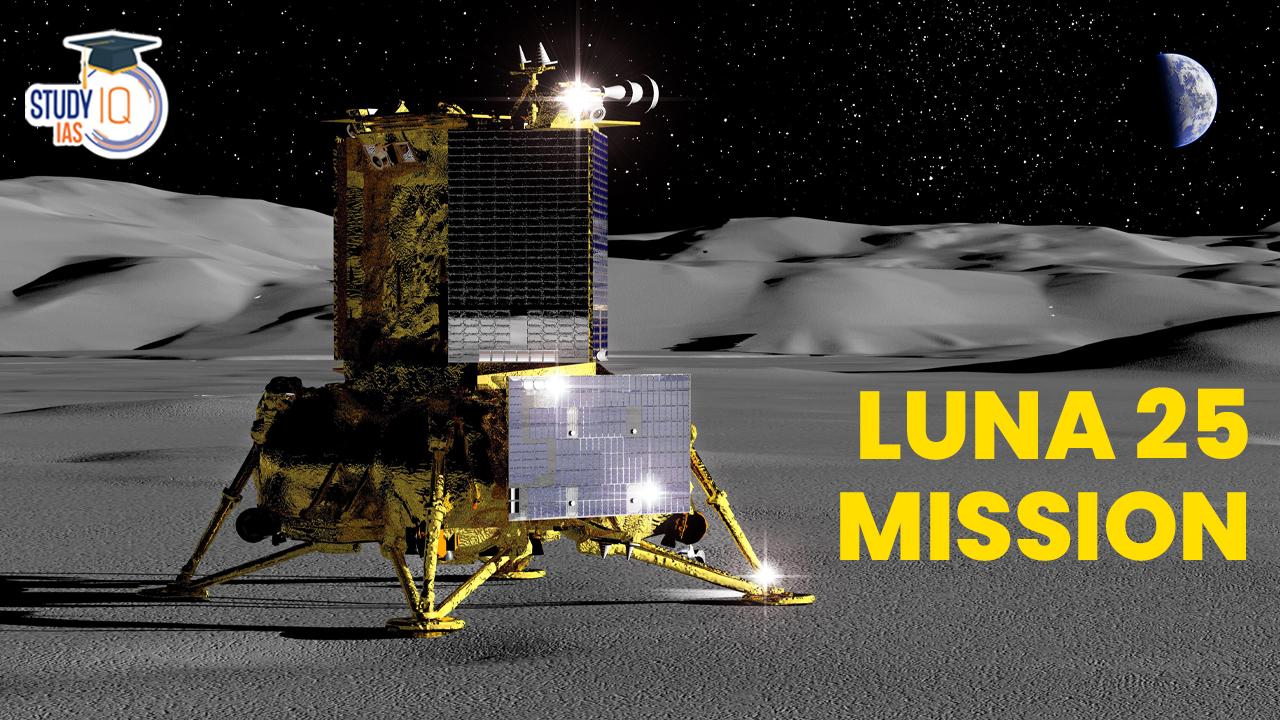Table of Contents
Luna-25 Mission
Luna 25 was a Russian lunar lander mission by Roscosmos in August 2023 that was slated to land near the lunar South Pole at the crater Boguslawsky. A Soyuz 2.1v rocket carrying the Luna-25 craft blasted off from the Vostochny cosmodrome, 5,550 kilometers east of Moscow, on August 11. On August 21, the lander is anticipated to make contact with the moon, according to Russia’s space chief. India’s lunar mission cannot touch down until August 23, when the landing spot would see lunar sunrise. On the moon’s South Pole, Luna-25, a vehicle about the size of a small car, plans to run continuously for a year.
Luna-25 Mission Ends in Failure
The long awaited Luna-25 lunar mission from Russia has experienced a serious setback after the spacecraft lost control and fell to the Moon’s surface. The failure emphasises that even the most cutting-edge equipment is prone to failure and serves as a sobering reminder of the unanticipated difficulties that come with space travel. This article explores the mission’s specifics, its ramifications, and Russia’s unwavering dedication to lunar exploration.
Russia Luna-25 Mission Crash and Investigation: Unraveling the Failure
The Luna-25 mission unfortunately took an unexpected turn when, just after a crucial manoeuvre, the spacecraft lost control and crashed onto the lunar surface. The specific causes of this failure are yet unknown, leading Russia’s space agency, Roscosmos, to undertake a thorough inquiry. The tragedy illustrates the need for precise preparation and in-depth risk assessment and underlines the intricate complexity of space travel.
Russia’s Lunar Exploration History
The last successful Russian lunar landing took place in 1976, leaving a sizable gap in the nation’s lunar exploration efforts. This historical context is made clearer by the Luna-25’s failure, which highlights the enormous difficulties that lunar missions involve. Despite this protracted break, Russia has shown tenacity and perseverance in its quest for lunar exploration.
Luna-25 Moon Mission
The moon’s South Pole is thought to contain significant ice deposits, and Luna-25, which will launch from the Vostochny cosmodrome, is intended to examine this area. Roscosmos guarantees that despite their close schedule, the Chandrayaan-3 and Luna-25 missions won’t collide because they are using different landing zones. The 1.8-ton spacecraft, which carries 31 kg of research gear and will orbit the moon for five to seven days, will then make its way to one of three prospective landing locations close to the pole.
Luna-25 Mission Objectives and Challenges
The main responsibility of Luna-25 is to gather rock samples from depths of up to 15 cm and examine them for the presence of frozen water, which is an essential resource for future lunar outposts. The launch was originally scheduled for October 2021, but due to complications, it was subsequently moved to August 11, 2023. Following Russia’s invasion of Ukraine in February 2022, the European Space Agency’s Pilot-D navigation camera, intended for testing on Luna-25, was dropped from the project.
Luna-25 Mission: A Lesson in Perseverance
The main responsibility of Luna-25 is to gather rock samples from depths of up to 15 cm and examine them for the presence of frozen water, which is an essential resource for future lunar outposts. The launch was originally scheduled for October 2021, but due to complications, it was subsequently moved to August 11, 2023. Following Russia’s invasion of Ukraine in February 2022, the European Space Agency’s Pilot-D navigation camera, intended for testing on Luna-25, was dropped from the project.
Luna 25 vs Chandrayaan 3
Luna-25 has a leaner lift-off mass of only 1,750 kilograms, significantly lighter than Chandrayaan-3’s 3,800 kg. This reduced mass allows Luna-25 to accelerate more effectively, according to India’s space agency ISRO.
| Difference | Luna 25 | Chandrayaan 3 |
| Definition | After 47 years, Russia returns to lunar exploration with Luna 25, hoping to restore its standing in space exploration. | India’s third lunar mission, Chandrayaan-3, marks the country’s second attempt at a gentle lunar landing. |
| Payload Difference | In order to examine soil composition, dust particles, and surface water detection, Luna 25 is lighter and does not have a rover. | Chandrayaan-3 is equipped with a rover that can go 500 metres, contains equipment to find water ice in shadowed craters close to the lunar South Pole, and is designed to explore the lunar soil. |
| Lifespan | Luna 25 has heating mechanisms and a non-solar power source because it is built for an extended mission of a year | As a result of inadequate heating during the lunar nights, Chandrayaan-3 is designed for a single lunar day. |
| Objective | The eight payloads on the Russian lander are primarily used to detect surface water, analyse soil composition, and analyse dust particles in the polar exosphere. | Scientific equipment is also available on the Indian mission to analyse the lunar soil and water ice. Because there are craters close to the southern polar region that are always in darkness, there is a higher chance of finding water ice there. |


 AI and its Regulation in India, Limitati...
AI and its Regulation in India, Limitati...
 Tuberculosis (TB), Symptoms, Causes and ...
Tuberculosis (TB), Symptoms, Causes and ...
 Nilgiri Biosphere Reserve, Map, Climate,...
Nilgiri Biosphere Reserve, Map, Climate,...





















